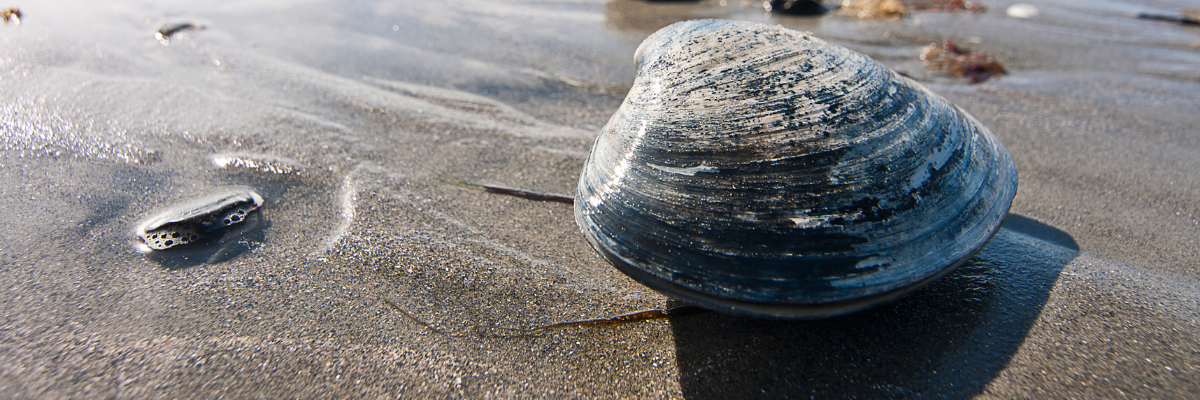You’ve heard the expression, ‘happy as a clam.’ But, it turns out, Florida’s clams aren’t all that happy.
Dr. Todd Osborne is hoping to change that.
Dr. Osborne is a biogeochemist at UF’s Whitney Laboratory for Marine Bioscience. With his team, he has been working to restore clams in the Indian River Lagoon. He presented some of their research during the “Clam Restoration Lunch and Learn” as part of the Virtual Water Ambassador Webinar Series, hosted by UF IFAS.
Here’s what I learned about clams, and the deep relationship between pollution, climate change, and filter feeders like shellfish.
Florida Clams 101:
Florida is home to a southern variety of what is known as the quahog round clam or hard-shell clam. These filter feeders live at the bottom of water bodies like the Indian River Lagoon and are often found digging themselves beneath the sand. Clams have a large-scale reproduction strategy: get together in large numbers and spawn en masse. Healthy clams can release as many as 2 million eggs per adult and typically do some twice a year when water temperatures change. Clams can live 10 – 15 years so with a healthy environment, clams can reproduce and multiply easily.
Having a healthy clam population can mean cleaner water and a cooler planet.
Clams clean water simply by eating and breathing. They eat microscopic plants like algae and phytoplankton through their tube-like siphons and filter nutrients like nitrogen through their gills as they breathe. Clams also help reduce particles in the water, which in turn clears the water. Clearer water allows more sunlight to penetrate through the water, ensuring that seagrasses (a main source of food and habitat for Florida marine life) can grow and flourish.
Clams are chemists. They may not wear goggles and lab coats, but they convert nitrogen (a pollutant when in excess) in the water into other sources that are less usable by algae. Through the digestion and excretion process, clams convert nitrogen in the food they eat and can also hold nitrogen within their bodies and shells. You can learn more about the in-depth chemical processes here.
Clams also help address climate change. Their shells can retain carbon as calcium carbonate, derived from atmospheric carbon dioxide (CO2) dissolved in seawater. Thus, their shells act as a long-term carbon sink and minimize ocean acidification. “Oyster and clam shells are nature’s version of Tums,” said Dr. Osborne.
Clams are cool (and kinda cute!). But they are also vulnerable. Our wild-caught clam industry peaked in the 1980s and 90s but over-harvesting has devastated Florida’s populations. With fewer clams, scientists noted that algae increased and there was a decrease in water clarity. This was recorded in New York and other clamming states as well. Sadly, in a matter of decades, clams went from thriving to barely surviving.
Much of Dr. Osborne’s clam research is from Indian River Lagoon. The Indian River Lagoon is a big system spanning more than 2,200 square miles from Mosquito Lagoon in Volusia to St. Lucie County. It is the most biologically diverse estuary in North America – or was, as Dr. Osborne noted. The health of the Indian River Lagoon is not only important to Florida but to the entire East Coast. What was once a picture of clear blue water and bountiful mangroves and seagrasses is now an algae-ladden system on the verge of collapse. Human pollution makes its way to the IRL through stormwater systems. When it rains, it pours. Pollution from fertilizers and waste holds lots of nutrients like phosphorus and nitrogen. Excessive amounts of these nutrients can cause explosive algae outbreaks. Algae is bad news for our water. Algal blooms can create toxins and/or take up oxygen as they decompose, suffocating marine life. Algae’s worst enemy: clams.
Dr. Osborne introduced us to his pride and joy: his lab-grown “Super Clams.” Bred and raised in the Whitney Lab, his clams (Merencaria catechesis) have been able to be successfully returned to clean, clear spots in the Indian River Lagoon.
Clams were once a big part of the Indian River Lagoon ecosystem, economy, and culture. Residents have recalled being able to hop out of their boats and easily harvest lots of clams. But those times are long gone.
To clean and restore the Indian River Lagoon, scientists look to control algae through predation. Dr. Osborne’s group of “Super Clams” have filtered millions of gallons of water a day, nearly 3 billion gallons a year! Additionally, they have sequestered 27,000 kilograms of carbon. Their good work can be even more impactful when paired with pollution prevention and carbon emissions.
Like clean water? Thank a clam. Our water and wildlife are connected and their health is key to maintaining the functioning ecosystems that we depend on. Dr. Osborne’s project, Restoring Native Clam Communities for Improved Water Quality and Economic Resiliency in the Indian River Lagoon, was a group effort that relied on local and state agencies, non-profits, and commercial partners. During the presentation, I noted that one of those partners was the local Environmentally Endangered Lands Program, passed by voter referendum.
How can you support clams and a healthy Indian River Lagoon? Hold your lawmakers accountable. Let your lawmakers know that clean water is important to you as a voter, and that you want them to prioritize pollution prevention. Share with them how clean water affects you and your family. While clams can’t vote or connect with lawmakers, you can! Speak up for marine life today.

